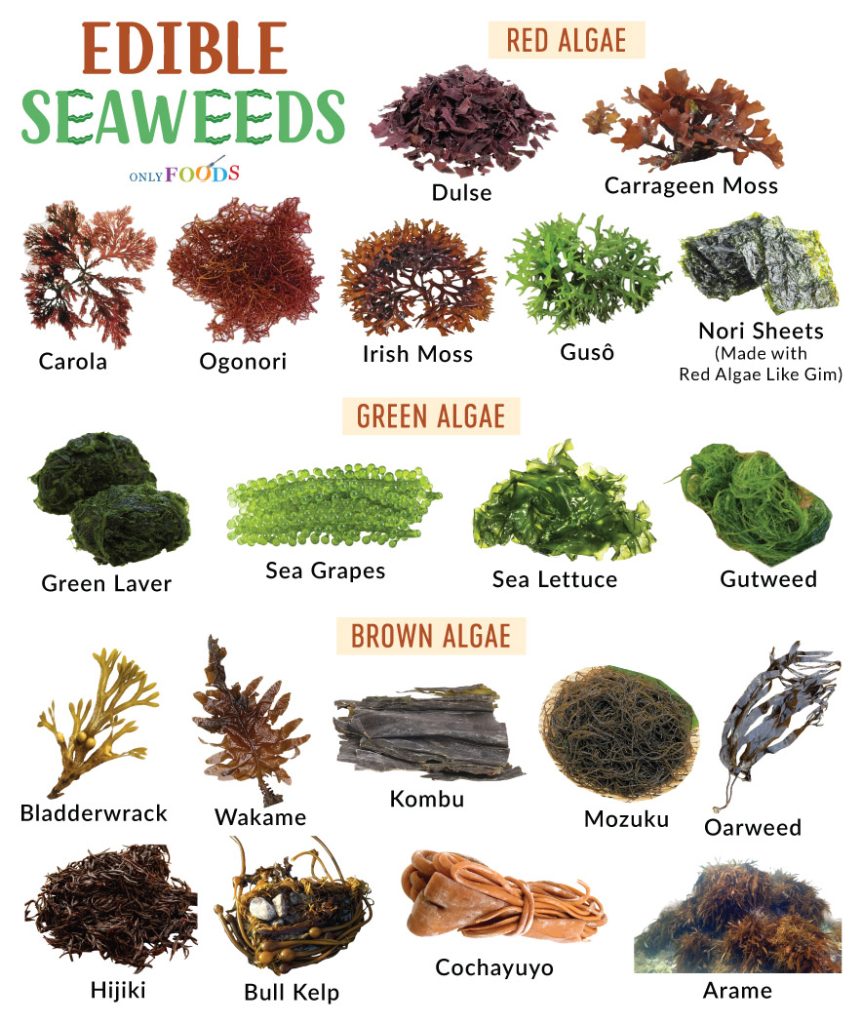Sea Vegetables (Edible Seaweeds)
Sea vegetables mainly refer to the edible seaweeds that are rapidly gaining popularity due to their delightful taste, texture, and rich nutrient content. Sometimes, the term may also include a few plants that grow on coastal shorelines and are used as food. The salicornia (marsh samphire in Britain), sea purslane, and sea beets are a few such examples. In this article, however, ‘sea vegetables’ refers to only edible seaweeds.
Despite being called sea ‘vegetables,’ seaweeds are not actual plants. They are various species of microscopic marine algae described as plant-like protists (living organisms that are not animals, plants, or fungi). These algae are divided into three groups – red algae (Rhodophyta), green algae (Chlorophyta), and brown algae (Phaeophyta).
Thousands of seaweed species exist, with only a few accepted as food. They are a common ingredient in Asian cuisines, including Chinese, Japanese, Korean, and Philipino cuisines. Other than Asia, seaweeds are traditionally used in certain Nordic and Polynesian cuisines and are commonly eaten in Scotland and Ireland.
List of Different Types of Edible Seaweeds
Many seaweeds may have multiple names; for example, hijiki is known as ‘tot’ in Korea. But the list below primarily mentions each type by its Japanese name, as that is more widespread in the United States.
Red Algae
- Nori
- Dulse
- Irish Moss
- Carola
- Ogonori
- Carrageen Moss
- Gusô
- Gamet
- Gim
- Gelidiella
- Laverbread
- Grapestone
- Hypnea
- Sea Sacs
Green Algae
- Sea Grapes (Green Caviar)
- Sea Lettuce
- Green Laver
- Gutweed
- Chlorella
- Oval Sea Grapes
Brown Algae
Kelps (Order – Laminariales)
- Arame
- Kombu
- Wakame
- Hiromi
- Bull Kelp
- Oarweed
- Giant Kelp
- Sea Palm
- Badderlocks
- Cochayuyo
- Sugar Kelp
- Ecklonia Cava
Fucales (Order)
- Hijiki (Hiziki)
- Bladderwrack
- Spiral Wrack
- Channelled Wrack
- Thongweed
- Limu Kala
Ectocarpales (Order)
- Mozuku
Various components derived from these algae are used for making condiments. A typical example would be agar-agar, a gelatin substitute typically used in different Asian cuisines.
Many of the types in the above list are available in markets as dry sheets or flakes that must be rehydrated before eating. Several food processing companies culture and harvest edible seaweeds from both the Atlantic and Pacific Oceans to make them easier to avail in the country.
Seaweed sheets, especially nori sheets, are an essential ingredient in making various types of sushi. They also make a great addition to soups, stews, and salads.
FAQ
Though they grow both in freshwater and saltwater, only the saltwater algae are safe for consumption. Most freshwater seaweeds are poisonous and can pose serious health risks if eaten.
As mentioned above, edible seaweeds are rich in proteins, vitamins, minerals, and many bioactive molecules. According to research, these phytonutrients, including polyphenols and polysaccharides, are believed to lower the risks of various health issues. Due to these possible benefits, seaweeds are gradually gaining popularity as a ‘superfood.’
Wakame and various types of kelps are particular favorites when making salads with seaweed.
Most store-bought seaweeds are already highly processed and are safe to eat raw. Even fresh raw seaweeds are valued for their naturally salty taste and are added to salads.

